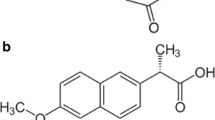Abstract
This study examined the effects of the particle size of various poorly water-soluble drugs on their dissolution behavior through physicochemical and mathematical analysis. As model drugs, hydrochlorothiazide, aceclofenac, ibuprofen and a discovery candidate were selected. The materials were crystallized using an evaporation method and milled without transformation behavior of crystal forms. The particles were sieved and divided into four size groups (< 45 μm, 45∼150 μm, 150∼250 μm, and 250∼600 μm). The specific surface area with regard to the particle size was measured using a BET surface area measurement. The specific surface area increased with decreasing particle size of the drug, resulting in an increase in dissolution rate. During the initial period of the dissolution study, significant differences in dissolution rate were observed according to the particle size and specific surface areas. On the other hand, in the later stages, the surface-specific dissolution rate was almost consistent regardless of the particle size. These observations were evaluated mathematically and the results suggested that the dissolution rate of poorly soluble drugs is strongly related to the particle size distribution. Moreover, physicochemical analysis helped explain the effect of particle size on the dissolution profiles.
Similar content being viewed by others
References
Anderberg, E. K., Studies on the dissolution of fine particulate practically insoluble drugs and on the effect of surface active enhancers on gastrointestinal absorption of hydrophilic drugs. Acta Univ. Ups., 91, 8 (1992).
Bisrat, M. and Nyström, C., Physicochemical aspects of drug release: VIII. The relation between particle size and surface specific dissolution rate in agitated suspensions. Int. J. Pharm., 47, 223–231 (1988).
Brockmeier, D., In vitro/in vivo correlation of dissolution using moments of dissolution and transit times. Acta Pharm. Technol., 32, 164–174 (1986).
Brunner, E., Theorie der Reaktionsgeschwindigkeit in heterogenen systemen. Z. Phys. Chem. (N F), 47, 56–102 (1904).
Buckton, G., Characterization of small changes in the physical properties of powders of significance for dry powder inhaler formulations. Adv. Drug Deliv. Rev., 26, 17–27 (1997).
Cao, W., Mullarney, M. P., Hancock, B. C., Bates, S., and Morris, K. R., Modeling of transmitted X-ray intensity variation with sample thickness and solid fraction in glycine compacts. J. Pharm. Sci., 92, 2345–2353 (2003).
Chaumeil, J. C., Micronization: A method of improving the bioavailability of poorly soluble drugs. Methods Find. Exp. Clin. Pharmacol., 20, 211–215 (1998).
Cospite, M. and Dominici, A., Double blind study of the pharmacodynamic and clinical activities of 5682 SE in venous insufficiency. Advantages of the new micronized form. Int. Angiol., 8, 61–65 (1989).
Coudoré, F., Harvard, L., Lefeuvre, S., Billaud, E. M., Beaune, P., Bobrie, G., Azizi, M., Prognon, P., and Laurent, S., HPLC-DAD Analysis of Hydrochlorothiazide and Irbesartan in Hypertensive Patients on Fixed-Dose Combination Therapy. Chromatographia, 74, 559–565 (2011).
Fini, A., Fazio, G., and Feroci, G., Solubility and solubilization properties of non-steroidal anti-inflammatory drugs. Int. J. Pharm., 126, 95–102 (1995).
Hixson, A. W. and Crowell, J. H., Dependence of reaction velocity upon surface and agitation. I Theoretical consideration. Ind. Eng. Chem., 23, 923–931 (1931).
Kim, B. Y. and Sohn, Y. T., Solid state of CG-400549, a novel FabI inhibitor: Characterization, dissolution, transformation. Arch. Pharm. Res., 34, 775–779 (2011).
Löbenberg, R. and Amidon, G. L., Modern bioavailability, bioequivalence and biopharmaceutics classification system. New scientific approaches to international regulatory standards. Eur. J. Pharm. Biopharm., 50, 3–12 (2000).
Mosharraf, M. and Nyström, C., The effect of particle size and shape on the surface specific dissolution rate of microsized practically insoluble drugs. Int. J. Pharm., 122, 35–47 (1995).
Nernst, W., Theorie der Reaktionsgeschwindigkeit in heterogenen Systemen. Z. Phys. Chem., 47, 52–55 (1904).
Niebergall, P. J., Milsovich, G., and Goyan, J. E., Dissolution rate studies: II. Dissolution of particles under conditions of rapid agitation. J. Pharm. Sci., 52, 236–241 (1963).
Noyes, A. and Whitney, W., The rate of solution of solid substances in their own solutions. J. Am. Chem. Soc., 19, 930–934 (1897).
Parrott, E. L., Comminution. Encyclopedia of Pharmaceutical Technology, Swarbrick, J. and Boylan, J. C., ed. 3, 101–121 (1990).
Posac, J. R., Vázquez, M. D., Tascón, M. L., Acuña, J. A., de la Fuente, C., Velasco, E., and Sánchez-Batanero, P., Determination of aceclofenac using adsorptive stripping voltammetric techniques on conventional and surfactant chemically modified carbon paste electrodes. Talanta, 42, 293–304 (1995).
Rasenack, N., Hartenhauer, H., and Müller, B. W., Microcrystals for dissolution rate enhancement of poorly watersoluble drugs. Int. J. Pharm., 254, 137–145 (2003).
Simões, S., Sousa, A., and Figueiredo, M., Dissolution rate studies of pharmaceutical multisized powders — a practical approach using the Coulter method. Int. J. Pharm., 127, 283–291 (1996).
Author information
Authors and Affiliations
Corresponding author
Rights and permissions
About this article
Cite this article
Chu, K.R., Lee, E., Jeong, S.H. et al. Effect of particle size on the dissolution behaviors of poorly water-soluble drugs. Arch. Pharm. Res. 35, 1187–1195 (2012). https://doi.org/10.1007/s12272-012-0709-3
Received:
Revised:
Accepted:
Published:
Issue Date:
DOI: https://doi.org/10.1007/s12272-012-0709-3




